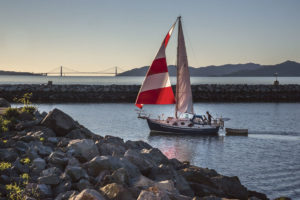The new Eastshore State Park comprises one of the largest undeveloped public landholdings fronting San Francisco Bay, stretching from the Bay Bridge in Oakland to Marina Bay in Richmond. The 8.5-mile-long, 260-acre park is the result of more than four decades of lobbying, negotiations, and ballot initiatives by local environmental activists. In 2000, the Department of State Parks, in conjunction with the East Bay Regional Park District, began the planning process for the new park.
Following regional workshops held to solicit comments from the public, the first general plan for the park was presented in March 2002. The plan attempts to reconcile the views of the two most vocal constituencies: recreation advocates and environmentalists. Soccer clubs, Little League groups, and other sports enthusiasts see the new park as an opportunity to address the shortage of playing fields in the East Bay. Other advocates for “active” recreational uses include kayakers, windsurfers, and fishermen, who want greater access to the shoreline and water. Of necessity, this entails the construction of parking and launching facilities.
The environmental groups that campaigned long and hard to make Eastshore Park a reality—Save the Bay, Citizens for the Eastshore State Park, Sierra Club, Golden Gate Audubon, and others—take a different view. “The idea of putting ball fields in one of the most environmentally sensitive areas of the East Bay seems ludicrous,” says Norman La Force, the author of Creating the Eastshore State Park: An Activist History. For environmentalists, the park is an opportunity to counter the effects of decades of filling the Bay and destroying wetlands, and for urban residents to observe and interact with a bayshore wildlife habitat that has disappeared from so much of the rest of the Bay. Arthur Feinstein, co-executive director of the Golden Gate Audubon Society, sees the Eastshore State Park as a “major opportunity to give our children a better understanding of our natural world.”
In the official plan, areas designated for habitat preservation include the Emeryville Crescent, the Albany Mudflats, and the South Richmond Shoreline/Hoffman Marsh. Other areas with established yet less pristine habitat, such as the Berkeley Meadow and the Albany Bulb, would be protected as open space with some “enhancement.” At the Albany Bulb this would include removal of artwork and nonnative plants, and banning of off-leash dogs. Still other areas, including the Albany Plateau, would be turned into facilities for active recreation, such as ball fields and boat launches. A group calling itself Albany/Let It Be has come together recently to oppose these measures for the Bulb in particular. They like the Bulb as it is, maintaining that artists, hikers, birders, and dog walkers coexist now, and enjoy the opportunity to have unmediated experiences.
East Bay residents can comment on the general plan by attending the regional planning workshops scheduled for October 2002, sponsored by the state and the East Bay Regional Park District. If you would like more information or want to get involved, contact the following organizations:
East Bay Regional Park District: http://www.ebparks.org/parks/eastshore
Albany/Let It Be: (510) 845-4809, www.albanyletitbe.com
Citizens for the Eastshore State Park: Sara Stern, (510) 848-0800, ext. 313
Golden Gate Audubon Society: (510) 843-2222
Sierra Club, SF Bay Chapter: Norman La Force, (510) 526-4362, nlaforce@ix.netcom.com


.jpg)